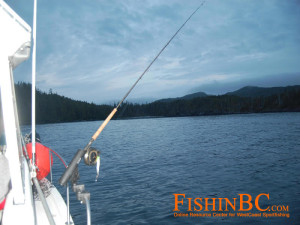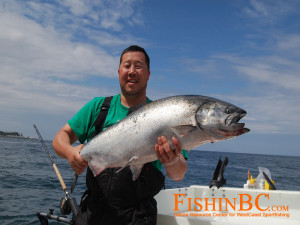Trolling with downriggers is an efficient method for catching salmon, and it’s real easy to do. But as with most things – you obtain the best results with attention to details and some additional, focused effort. This article includes my strategic tips for salmon trolling to put more fish in your boat. These trolling tips are primarily for chinook salmon downrigger fishing but can be applied to trolling for coho and other salmon species, and other methods like salmon mooching and jigging.
Prepare Cut Plug Trolling Rigs on Spare Rods in Advance

Check for Weeds Frequently
When I’m salmon trolling with downriggers I like to check the gear every 15-20 minutes. A quick press of the downrigger button and the downrigger will haul the gear to the surface. It only takes 30 seconds to raise the gear and visually confirm there are no weeds and recheck the spin on the bait. You do not need to pop the bait off the rigger to check its roll, just raise the rod tip enough and the herring will rise close to the surface where you should be able to see its roll. If the lines and the cut plug herring rig is all good then it is back down fishing with no more than 1 minute of time spent in the check. If there were weeds or the bait was not spinning right then by checking the bait you have saved yourself from potentially a half hour or full hour of unproductive trolling. If you find you have weeds get them off quickly. If your cut plug is not rolling right, quickly grab one of your spare, pre-rigged rods, clip it to the line and get it back to the fishing depth. It is possible to complete a full check including replacing a rod with a pre-rigged setup in less than 90 seconds. Think of it like a downrigger olympics and challenge your crews to see who can run the most efficient side of the boat. The extra time that lines are productively fishing in the water does make a difference to the number of fish landed in a day!
Resume Trolling Immediately after Catching a Fish

Move Offshore when you are Playing the Chinook
When trolling for chinook around structure such as points and kelp beds it is probable that there will be a bunch of other boats trolling in the area and everyone will be circling around in a fairly predictable pattern. Once you catch a fish the very best thing you can do for yourself, and for the other anglers, is to keep your boat in gear and start to head the boat offshore. The chinook may take a run toward the shore but you do not need to chase after it right away, your reel will have around 900 feet of line or more. Generally you will be able to coax the chinook to turn around and then it will start following you offshore. This is important because it gives you space from the other anglers who will most likely be swooping in on the apparent “hotspot”. I like to free up the hotspot once I have a fish so that the other anglers can have a shot. I have fished in situations where some anglers held their boat in neutral right on the hotspot for 40 minutes while fighting the fish and it was fairly frustrating for all the other boaters watching the entire peak bite time pass by unable to enter the prime fishing zone. The captain certainly could have maneuvered away and freed up the spot for everyone else. If you do not move away you run the risk that other boaters will become frustrated and potentially try to troll through the hotspot, within the comfort zone of your angler.
Clean your Fish on the Boat
If you normally bleed your fish as soon as you catch them, and then spend 1hr cleaning all your fish back at the dock, consider that if you clean your fish on the boat, then you can spend that extra 1hr with the trolling gear still fishing on the downrigger. On my boat I built a massive custom fish cleaning table across the back for this purpose and it is likely the greatest efficiency that I have installed on the boat.
Check out the FishinBC.COM post How to Build Your Own Fish Cleaning Table for more information.
.
Troll with Only as many Rods as you can Control
Downriggers are easy to use and it is possible to stack multiple rods on each one thus potentially increasing the number of lures in the water and the broader depth of water column that can be fished. There are pros and cons to trolling with multiple rods and the captain and crew must ensure that they are able to actively manage all the rods. On my boat when fishing Chinook salmon I prefer to run two rods because I can very easily control them and I can stay on top of them, including frequent weed checks. I have also fished with 4 rods, 2 stacked on each downrigger lots. This method has resulted in good success but when the crews start getting tired and particularly if there are a lot of weeds and debris floating in the water, I find that weed checks become less frequent and trolling with weedy gear is not going to catch any fish. As the captain keep an eye on the crew and understand their energy level and ensure they are fishing the right number of rods.
Target Moderate Tide-Swings for Downrigger Trolling Success
Every 14 days there is going to be either a full moon or a new moon. During the full or new moon phases the tides are at their highest variance and what I find during this period is that there is typically the highest amount of drifting seaweed present. A storm combined with a strong tidal current tends to rip out kelp and all kinds of flotsam and that can make trolling frustrating if you are constantly crossing through weed lines. It is particularly difficult to negotiate floating weeds and kelp when fishing a salmon hotspot such as a point or kelp bed, among a lot of other boats. So something to keep in mind is to check the lunar phase and you may wish to avoid those large tide swings and pick your fishing days to correspond with lesser tides. I think that a tide swing around 10 feet is optimal, a tide swing of 20 feet is extreme. I recommend anything in the 15-20 foot range is worth deliberately avoiding if you can because there will be a lot of current flowing.
How to get a Double Header
I have said this before in my other posts on salmon fishing, and I’ll repeat it here because it is important. Chinook salmon like to travel together in small groups and so when you get one hit or one fish on there is a decent chance that you are in a prime location, and, that there is a second or third chinook nearby. With one angler grabbing the rod that has the fish, the captain can be fairly sure that the fish will tend to sound for the bottom and thus should not risk tangling with the other rod (sounding is normal Chinook behavior). Therefore leave the other rod on the downrigger and keep trolling for another 60 seconds or so just to see if you get another hit. After that and if the first angler has a pretty big fish on, you are going to want to pull up the other gear and get the downriggers out of the way so that the angler can play the fish and the netter can have a clear shot.
Your Turn!
Hopefully you can put these downrigger trolling tips to good use on your next trip. If you have any questions about these ideas or other great ideas that have brought you increased success leave a comment in the comments box below!
Tight Lines! FishinBC.COM
My husband and I are new to fishing and would like to know how you set up your fishing rod and downrigger for trolling on the BC West coast. Thanks for any advice.